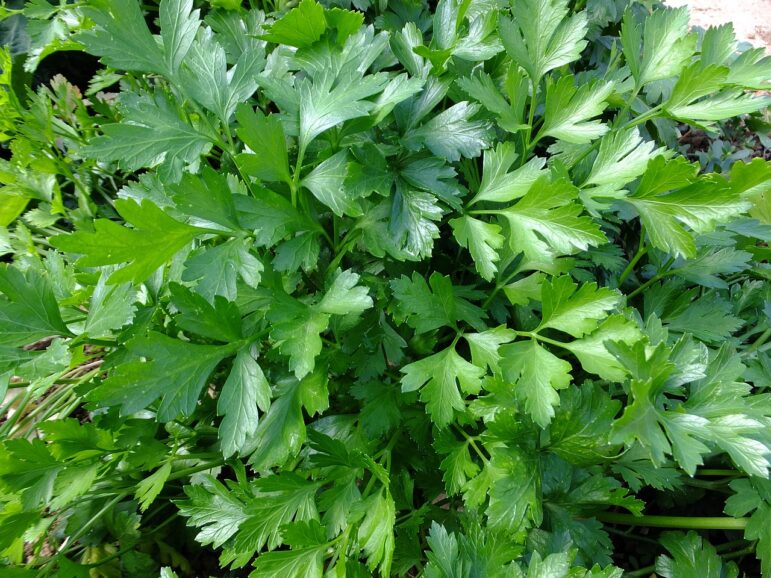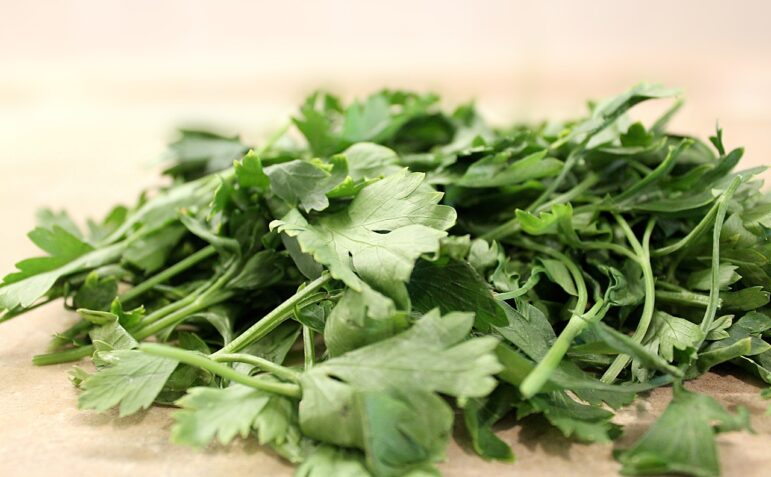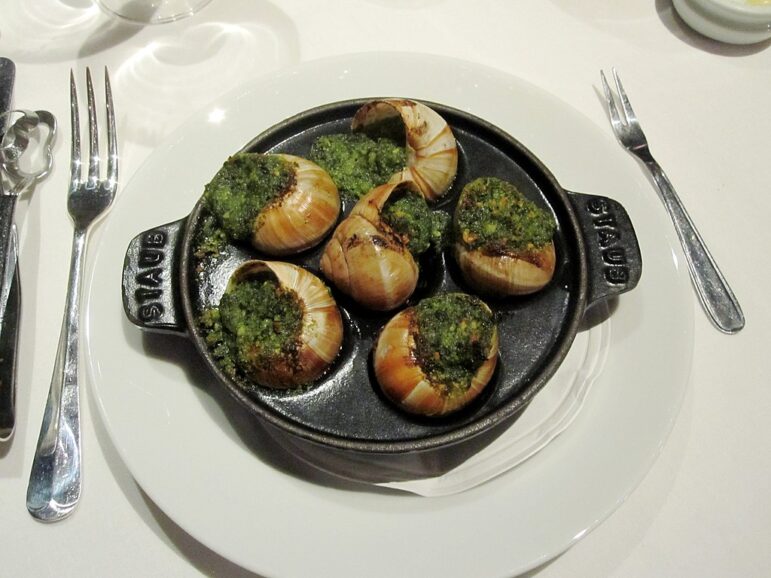
Editor’s note: Today’s offering includes a reference to a myth about the death of a child.
Parsley is often seen as the most boring of the culinary herbs, and for this I blame those horrible papery green shreds found in jars at the grocery store. Parsley is not an herb that really survives the drying process, tastewise anyway, but when fresh and deployed in handfuls then its ubiquity in cuisines from North Africa to the far end of Europe suddenly makes a lot of sense.
Whatever you think of the taste and its position in the culinary hierarchy, however, parsley’s role in folklore and magic is significantly more dramatic, bringing together life, death, love, and demons like the very best of operatic metal albums.

Parsley [baakk, Pixabay]
Parsley actually has a lot in common with mint, both in its association with the underworld and several of its magical uses. There’s no seductive water nymph or vengeful goddesses involved here, however. Instead a far more mundane tragedy bound parsley to the dead in Greco-Roman myth – the death of Opheltes, infant prince of Thebes. Killed by a snake after his nurse laid him on the ground when she went to fetch water for a group of visiting heroes, one version of the legend says she placed him on a bed of parsley where the snake lurked, another that parsley first sprang from where drops of his blood landed on the soil.
Used to decorate the tombs of the dead, parsley was counted as a cthonic herb, sacred to Persephone, and as an ill omen signifying death or disaster. Ironically this tie to death would later grant parsley an association with victory too, as the victors of the Nemean Games – quadrennial games said to have been founded as funeral games for Opheltes, who was posthumously renamed Archemorous, “forerunner of death” – were woven from the herb.
As Christianity displaced paganism, parsley came to be associated with a different underworld figure, one ambiguously malevolent. Possessed of a lengthy germination period, parsley was accused of having to grow down toward the devil first before it could sprout, and any problems gardeners faced rearing the notoriously finicky plant were blamed on this fell relationship.
Some regional folklore held that parsley needed to be sown nine times, as the devil would take the first eight rounds of seeds. Other lore said that the soil had to be doused with hot water first before planting to scare him away. Still more believed that parsley would only grow for “the wicked”; others that it required a bachelor or a man who was dominated by his wife (unhappily) to produce a successful crop as marital harmony would keep it from taking root.
As difficult as it was to grow however, the discovery of parsley that had seeded itself in someone’s garden was far worse, as, carrying forward ancient Greek beliefs about omens of doom, some parts of Christianised Europe believed this heralded a death before the year was through.
Even if you triumphed over the devil well enough to convince parsley to grow in your garden, the metaphysical danger posed by the plant to your loved ones had only just begun. Transplanting parsley could result in dead, maimed, or severely ill relatives, as the offended spirit of the plant sought revenge for it’s displacement (and indeed, parsley is not a plant that appreciates being moved, struggling as it does to survive the transition). Cutting parsley while in love was said to kill the object of your affections, and if you weren’t in love yet it would doom future romantic endeavours, condemning you to unhappiness.
The people of Surrey, England, went so far as to say that growing parsley at all was likely to result in a death in the family by year’s end, whether the householders had deliberately planted it there or not. Of course, for the more murderously inclined kitchen gardener, parsley’s homicidal tendencies could be steered or harnessed; speaking your intended victim’s name aloud as you plucked its leaves was seen as a surefire way to see them dead within a week.

Parsley [tortic84, Pixabay]
Despite, or perhaps because of this, in the apotropaic tradition, parsley was also believed to be extremely effective at warding away evil. During the Roman era, brides would be given wreaths of herbs that included parsley in order to keep away evil spirits, and much later Polish brides would do the same. Well into the Christian era, people would carry sprigs or sachets of parsley on their person, and scatter it around the doors and windows of their homes, the spiritual entry points, to defend themselves against evil entities and malign magic. Farmers would do similarly to protect their livestock, padding out cracks in barn walls with the herb, and on the summer solstice in parts of Eastern Europe it was fed to cows to keep witches from interfering with their milk supply.
It was even used as a curse breaker in Southern France and Northern Spain, made into a tea that may or may not have included holy water at times – a nice piece of syncretic folk belief the church likely disapproved of.
When something is associated with both life and death, a secondary association with sex, love, and fertility almost always follows, and parsley is no exception. When not presaging death among the household, planting parsley signified, or perhaps even caused, a pregnancy instead, and one that would come to term before the seeds had finished germinating. So too parsley wine was drunk as an aphrodisiac, and some traditional lies told to children had babies left in the parsley rather than cabbage patch.
In Germany parsley was carried as a charm to ensure the fidelity of a partner, most often by brides on their wedding day, as well as featuring in any number of love and relationship spells in both folk and contemporary magical traditions.
Parsley’s dual nature can be found here too, as, despite its connection to fertility and babies, it was also traditionally used as a herbal abortifacient, albeit a particularly ineffective and dangerous one. Much like pennyroyal, another herb sacred to Persephone, parsley is only effective in this capacity when consumed in high enough dosages to trigger organ damage, with an Argentinian woman known to have died as a result as recently as 2018.
Unfortunately, with the rise of increasingly restrictive abortion laws in the USA and elsewhere, we’re likely to see an increase in clandestine, self-managed attempts, which is why it’s so important to raise awareness about the incredible dangers involved in these methods when discussing the history and folklore that’s tied to them.
As I’ve pointed out before, everything is connected, and as Pagans we’re supposed to be aware of that and act accordingly; one way to do so, to honour our ancestors, herbcraft, and life itself, is to advocate for pregnant people today so they don’t, in desperation, resort to the dangerous methods of the past. Parsley is an excellent culinary herb, with many wonderful spiritual uses; let’s work together to make sure that’s all it’s used for going forward.
Persillade
A French sauce that can be used on basically everything, persillade is far superior to the English parsley sauce that’s so beloved here. Intensely flavoured and a vibrant green, it’s wonderful swirled into soups or used as a condiment on grilled meat. Load up on it for the Samhain season; if the parsley doesn’t keep work to keep fell spirits away the sheer amount of garlic certainly will.

Escargot à la Bourguignonne, featuring persillade [eatingeast, Wikimedia Commons, CC 2.0]
Ingredients
- A small bunch of fresh, flat leafed parsley
- Garlic cloves (at least two, more is better)
- Half a lemon
- Olive oil
- Pinch of salt
Finely chop the parsley and garlic, squeeze the lemon over them and grate some of the zest in as well, then add olive oil, stirring slowly until you have a good, smooth texture. It is of course easier to do this in a food processor, adding the olive oil slowly until you have the right consistency. Finally taste it and then add enough salt to give it a little umami punch.
Making this kind of sauce is never an exact science as so much depends on the intensity and consistency of the raw ingredients, but don’t worry, if the balance of flavour or textures is off it’s easy enough to fix by adding more of the other ingredients until you’re happy with the final result. If you find you have a little extra in the fridge left over as a result, well now you’ve got a delightful condiment for your lunch the next day as it goes well on sandwiches and salads, from potato to pasta.
The Wild Hunt is not responsible for links to external content.
To join a conversation on this post:
Visit our The Wild Hunt subreddit! Point your favorite browser to https://www.reddit.com/r/The_Wild_Hunt_News/, then click “JOIN”. Make sure to click the bell, too, to be notified of new articles posted to our subreddit.